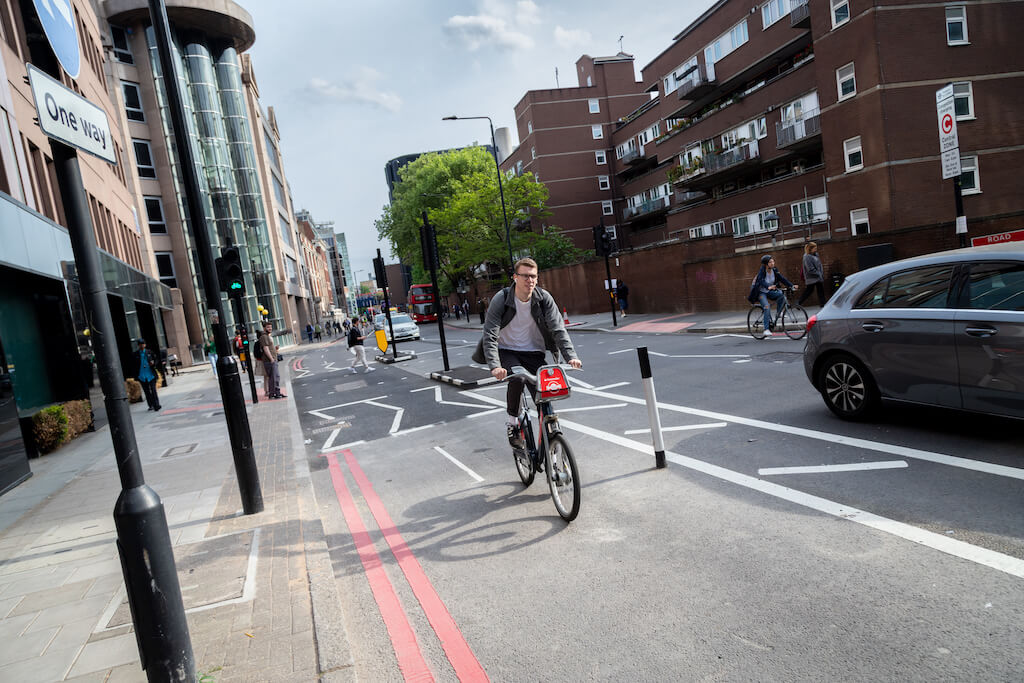Autumn Gear Guide
Find inspiration in our Gear Guide that will keep you out on your bike through wind or rain.
Download NowCycling in London has experienced a remarkable resurgence, with the latest data from Transport for London (TfL) indicating a 20% increase in cycling in 2023 compared to the pre-pandemic baseline in 2019. The findings, presented in the Travel in London report, showcase a positive trajectory for cycling, building on the momentum gained during the COVID-19 […]
Cycling in London has experienced a remarkable resurgence, with the latest data from Transport for London (TfL) indicating a 20% increase in cycling in 2023 compared to the pre-pandemic baseline in 2019. The findings, presented in the Travel in London report, showcase a positive trajectory for cycling, building on the momentum gained during the COVID-19 pandemic.
‘I’m delighted to see the increase in cycling and walking journeys in London continue for yet another year,” said Will Norman, London’s Walking and Cycling Commissioner. “The Mayor and I are committed to boosting this further. We will continue to expand the network of cycleways and make more junctions and crossings safer. We’re determined to build a cleaner, greener and more prosperous London for everyone, and investing in sustainable transport options is a vital part of that.”
The 2000s and early 2010s witnessed a surge in cycling popularity in London, followed by a plateau in the late 2010s. However, the pandemic acted as a catalyst for change, sparking renewed interest in cycling and resulting in a substantial growth of 20% in 2023 compared to 2019. The pandemic-induced changes, such as hybrid working practices, have left a lasting impact on commuter cycling volumes, particularly in central London.
While the overall cycling numbers have surged, there have been notable changes in the characteristics of these journeys. The average length of cycling trips has decreased, indicating a shift towards shorter, more localized travel. Additionally, the demand profile has become less ‘peaky,’ with a higher proportion of off-peak travel compared to the pre-pandemic period.
Examining different areas of London, the data reveals a 1.7% increase in daily cycling trips in central London between 2022 and 2023. In contrast, inner London experienced an 8.2% growth, surpassing 600,000 daily cycle stages for the first time. Outer London also contributed to the overall surge with a 5.5% increase.

Santander Cycle customer (photo: TFL)
The Santander Cycles scheme, an integral part of London’s cycling infrastructure, witnessed a five percent increase in annual demand in 2022 compared to the previous year, setting a new record. Noteworthy changes, including the introduction of e-bikes for hire and fare system restructuring, were implemented in autumn 2022. While these changes led to a drop in overall demand, e-bikes gained popularity, with over 684,000 trips made in the first year of their introduction.
In addition to Santander Cycles, TfL has been actively involved in an e-scooter trial scheme covering 10 boroughs. This initiative has facilitated over 3.1 million journeys through a fleet of over 5,200 e-scooters and more than 780 parking bays.
The Cycling Action Plan 2, published in June 2023, aims to have 40% of Londoners living within 400 meters of the strategic cycle network by 2030. As of November 2023, 24.2% of Londoners already lived within this proximity, up from 21.9% in 2022 and a mere 5% in 2016.
The report also highlights the positive impact of cycling growth on Londoners. In the financial year 2022/23, cycling accounted for 4.5% of all journeys in London, up from 3.6% in 2019/20. Moreover, the proportion of Londoners cycling in the past year increased across all ethnic groups, with a notable rise among Black and Asian communities.
Earlier this year, London announced an ambitious new cycling plan.
The Cycling Action Plan outlines ambitious goals to enhance past achievements, aiming to increase daily cycle journeys to 1.6 million by 2030, a third higher than the 1.2 million in 2022. Additionally, the plan seeks to elevate accessibility by targeting 40 percent of Londoners living within 400 meters of the Cycleway network by 2030, a significant rise from the current 22 percent in 2022.
TfL’s Chief Customer and Strategy Officer, Alex Williams, emphasized the essential role of walking and cycling in London’s sustainable future. The data reinforces the importance of investing in high-quality infrastructure to encourage healthy, sustainable, and affordable modes of transportation. As London continues to build a cleaner and greener future, cycling remains at the forefront of the city’s sustainable transport agenda.
“We’re determined to ensure that the way people travel in London is healthy, sustainable and affordable, which is why we will keep working closely with boroughs to transform our roads and invest in our transport network, enabling even more people to choose to make their journeys by walking, cycling and using public transport,” he said.
Find inspiration in our Gear Guide that will keep you out on your bike through wind or rain.
Download Now
Leave a comment